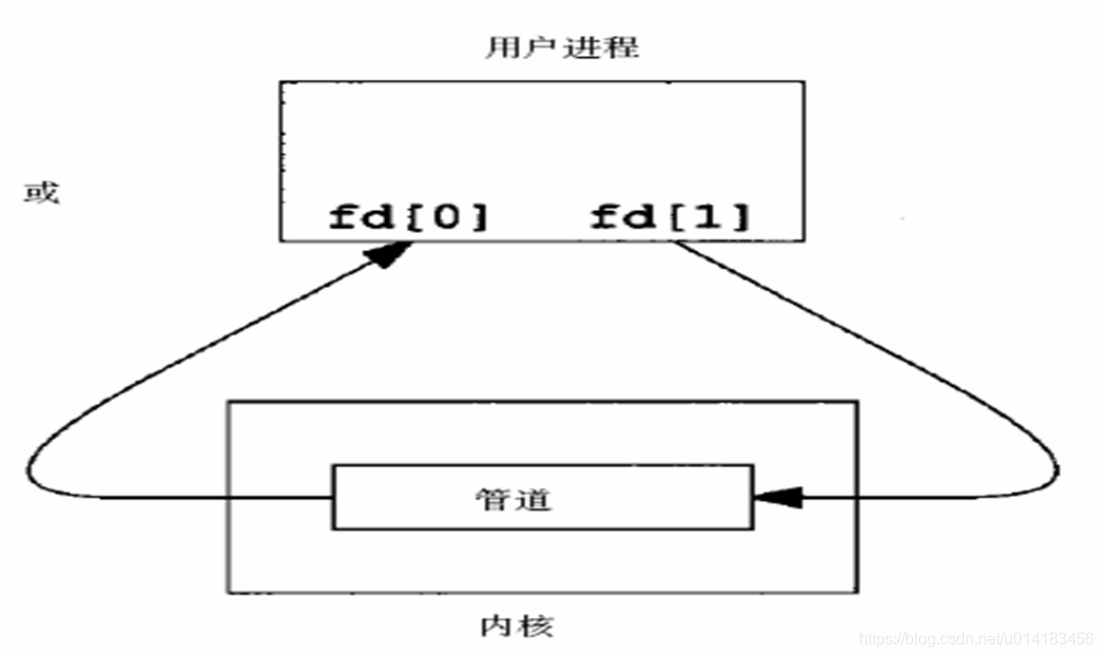管道通信
管道是单向的、先进先出的,它把一个进程的输出和另一个进程的输入连接在一起。一个进程(写进程)在管道的尾部写入数据,另一个进程(读进程)从管道的头部读出数据
管道创建
管道包括无名管道和有名管道两种,前者用于父进程和子进程的通信,后者可用于运行于同一系统中的任意两个进程间的通信。
无名管道由pipe()函数创建:
int pipe(int filedis[2]);
当一个管道建立时,它会创建两个文件描述符:filedis[0]用于读管道,filedis[1]用于写管道。

管道关闭
关闭管道只需将这两个文件描述符关闭即可,可以使用普通的close函数逐个关闭
#include <unistd.h>
#include <errno.h>
#include <stdio.h>
#include <stdlib.h>
int main()
{
int pipe_fd[2];
if(pipe(pipe_fd)<0) //创建管道
{
printf("pipe create error\n");
return -1;
}
else
printf("pipe create success\n");
close(pipe_fd[0]); //关闭管道
close(pipe_fd[1]);
}
管道读写
管道用于不同进程间的通信。通常先创建一个管道,再通过fork函数创建一个子进程,该子进程会继承父进程所创建的管道。

父进程用于从管道写入数据,子进程用于从管道读取数据。
注意:必须在系统调用fork()前调用pipe(),否则子进程将不会继承文件描述符
#include <unistd.h>
#include <sys/types.h>
#include <errno.h>
#include <stdio.h>
#include <stdlib.h>
int main()
{
int pipe_fd[2];
pid_t pid;
char buf_r[100];
char* p_wbuf;
int r_num;
memset(buf_r,0,sizeof(buf_r));
/*创建管道*/
if(pipe(pipe_fd)<0)
{
printf("pipe create error\n");
return -1;
}
/*创建子进程*/
if((pid=fork())==0) //子进程
{
printf("\n");
close(pipe_fd[1]);
sleep(2); /*为什么要睡眠 给父进程写的时间*/
if((r_num=read(pipe_fd[0],buf_r,100))>0)
{
printf( "%d numbers read from the pipe is %s\n",r_num,buf_r);
}
close(pipe_fd[0]);
exit(0);
}
else if(pid>0)
{
close(pipe_fd[0]);
if(write(pipe_fd[1],"Hello",5)!=-1)
printf("parent write1 Hello!\n");
if(write(pipe_fd[1]," Pipe",5)!=-1)
printf("parent write2 Pipe!\n");
close(pipe_fd[1]);
sleep(3);
waitpid(pid,NULL,0); /*等待子进程结束*/
exit(0);
}
return 0;
}
在linux上运行的结果:

有名管道(命名管道)
命名管道和无名管道基本相同,但也有不同点:无名管道只能由父子进程使用;但是通过命名管道,不想关的进程也能交换数据
创建
#include<sys/types.h>
#include<sys/stat.h>
int mkfifo(const char* pathname,mode_t mode)
*pathname:FIFO文件名
*mode:文件属性
一旦创建了一个FIFO,就可以用open打开它,一般的文件访问函数(close,read,write等)都可用于FIFO
操作
当打开FIFO时,非阻塞标志(O_NONBLOCK)
将对以后的读写产生如下影响:
1、没有使用O_NONBLOCK:访问要求无法满足时进程将阻塞。如试图读取空的FIFO,将导致进程阻塞
2、使用O_NONBLOCK:访问要求无法满足时不阻塞,立刻出错返回,errno是ENXIO
读文件
#include <sys/types.h>
#include <sys/stat.h>
#include <errno.h>
#include <fcntl.h>
#include <stdio.h>
#include <stdlib.h>
#include <string.h>
#define FIFO "/tmp/myfifo"
main(int argc,char** argv)
{
char buf_r[100];
int fd;
int nread;
/* 创建管道 */
if((mkfifo(FIFO,O_CREAT|O_EXCL)<0)&&(errno!=EEXIST))
printf("cannot create fifoserver\n");
printf("Preparing for reading bytes...\n");
memset(buf_r,0,sizeof(buf_r));
/* 打开管道 */
fd=open(FIFO,O_RDONLY|O_NONBLOCK,0);
if(fd==-1)
{
perror("open");
exit(1);
}
while(1)
{
memset(buf_r,0,sizeof(buf_r));
if((nread=read(fd,buf_r,100))==-1)
{
if(errno==EAGAIN)
printf("no data yet\n");
}
printf("read %s from FIFO\n",buf_r);
sleep(1);
}
pause(); /*暂停,等待信号*/
unlink(FIFO); //删除文件
}
写文件
#include <sys/types.h>
#include <sys/stat.h>
#include <errno.h>
#include <fcntl.h>
#include <stdio.h>
#include <stdlib.h>
#include <string.h>
#define FIFO_SERVER "/tmp/myfifo"
main(int argc,char** argv)
{
int fd;
char w_buf[100];
int nwrite;
/*打开管道*/
fd=open(FIFO_SERVER,O_WRONLY|O_NONBLOCK,0);
if(argc==1)
{
printf("Please send something\n");
exit(-1);
}
strcpy(w_buf,argv[1]);
/* 向管道写入数据 */
if((nwrite=write(fd,w_buf,100))==-1)
{
if(errno==EAGAIN)
printf("The FIFO has not been read yet.Please try later\n");
}
else
printf("write %s to the FIFO\n",w_buf);
}